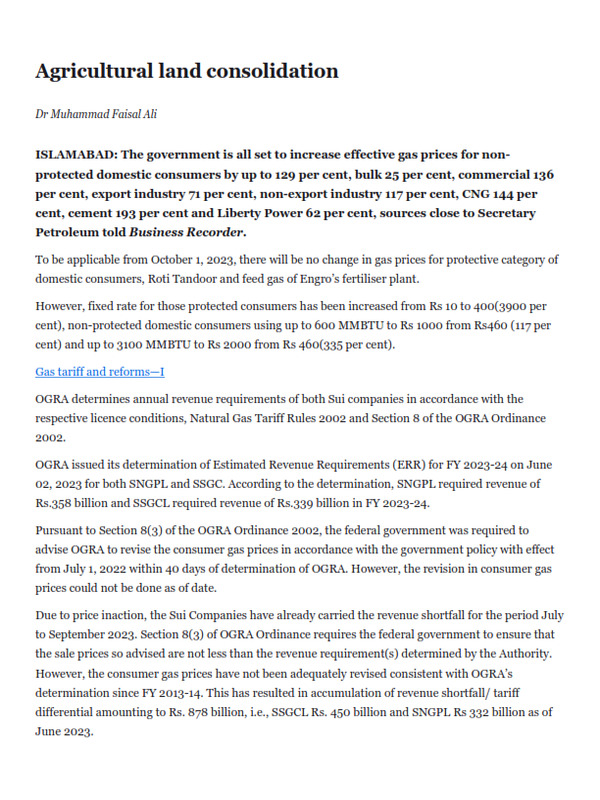Agricultural land consolidation
Agricultural land consolidation is a land management procedure which entails restructuring, reorganization or redistribution of land holdings by reducing number of plots or parcels to create larger, more efficient, and more logically shaped land holdings.
Pakistan’s agricultural landscape is characterized by small and fragmented land holdings. The average landholding size is relatively small, making it challenging for farmers to adopt modern farming techniques, mechanization, and efficient resource management.
As a result of which, productivity remains low, and the sector’s growth potential is largely untapped. To harness the full potential, Pakistan must consider Agriculture Land Consolidation (ALC) as a strategic solution.
It is imperative to begin by comprehensively understanding both present and past trends in distribution of agricultural land in Pakistan. Agricultural land distribution has undergone a rapid transformation. Over the last five decades, the number of farms has surged, rising from 3.76 million to 8.26 million.
Notably, the pace of this increase accelerated significantly, particularly between 2000 and 2010, when the number of farms expanded from 6.62 million to 8.26 million, representing an astonishing 25 percent growth rate. This data is 13 years old, and there have been no agricultural censuses conducted since 2010. Therefore, it’s plausible that, based on past trends, the current figure could be around 10 million.
When considering average farm size, 64 percent farmers have less than 5 acres of land. If this threshold is raised to 12.5 acres, the percentage rises to 89 percent, highlighting significant presence of small and medium-sized farmers in Pakistan. When average farm size within sub-categories is examined, they tend to be smaller.
Further, a diminishing trend in both, average farm size and average cultivated area has been observed consistently. Specifically, the average farm size decreased from 13 acres to 6.4 acres between 1972 and 2010, while the average cultivated area declined from 10.8 acres to 5.2 acres over the same period.
This situation worsens in case of fragments. The average number of fragments per farm is three in Pakistan. Out of the total 8.26 million farms, 34 percent exhibit fragmentations, accounting for a total of 8.58 million fragments. Among the 8.56 million fragments, 6.55 million fragments are associated with farmers who own less than 12.5 acres of land.
Analyzing distribution of fragments in more depth conclude that 2.1 million farms have an average of 2-3 fragments, 0.45 million farms have an average of 4-5 fragments, 0.24 million farms have an average of 6-9 fragments, while 9053 farms possess more than 10 fragments in Pakistan.
Fragmented land can lead to inefficiencies in land use, making it difficult to implement cohesive and productive agricultural strategies. ALC helps in reducing the fragmentations, by consolidating these parcels, farmers can create larger and more uniform fields, making it easier to use modern farming equipment and practices effectively.
ALC allows better land use planning at both the local and regional levels balancing agricultural needs with other developmental priorities. Therefore, ALC emerges as the most fitting solution in response to diminishing land sizes and increasing fragments. This approach has demonstrated its effectiveness in numerous regions worldwide, including countries such as China, Japan, India, and Turkey.
Smaller farms often encounter obstacles when attempting to adopt modern farming machinery due to their limited scale. Through consolidation, there will be increased access to mechanization and financial resources.
Larger, consolidated fields are better suited for the use of modern agricultural machinery, such as tractors, combine harvesters, and advanced irrigation systems, which can significantly increase efficiency and speed of various farming operations, from planting to harvesting.
ALC often leads to economies of scale, providing advantages of bulk purchasing of inputs such as seeds, fertilizers, and pesticides, and benefit from lower per-unit production costs. This can result in increased profitability and productivity.
This, in turn, enables small farmers to engage in value-added activities such as food processing, packaging, and marketing, while also gaining access to larger markets through the establishment of efficient value chains. Ultimately, this enhances their profitability.
The legal framework provides an avenue for residents in a particular area to instigate ALC, contingent upon their ability to provide documented evidence that a majority, specifically 51 percent at least, of the village’s inhabitants support the initiative.
Those in support can propose a consolidation scheme, which the revenue officer will publish as it falls under the jurisdiction of the Board of Revenue. If no objections are raised within a specified timeframe, the scheme can be implemented. In case objections do arise, individuals can file an appeal with the collector within 60 days.
If the issue remains unresolved, a subsequent appeal can be made to the commissioner within another 60-day period, with the commissioner serving as the final authority in such matters. In situations where the applicant does not submit a consolidation scheme, the revenue officer is responsible for preparing one, following the same procedure.
If the number of individuals willing to participate in land consolidation is less than 51 percent, consolidation can still proceed, but it will only apply to those who have requested it.
However, a profound awareness of the intricate web of land ownership and the social dynamics is essential when implementing ALC. Moreover, precise and up-to-date land documentation, local zoning regulations dictating permissible land uses, as well as land subdivision and consolidation rules, hold paramount significance.
Challenges associated with land titles, boundary disputes, tenancy rights, and the maintenance of land records can pose obstacles. Further, land consolidation may encounter resistance from landowners who harbor concerns about potential encroachment on their land rights. But, they can be resolved through careful strategizing, efficient and transparent regulatory mechanisms, and active community involvement.
The legal provisions coupled with promising advantages create a strong case for embracing ALC in Pakistan. It would lay the foundation for a more prosperous and sustainable agricultural future. This transformation will not only bring benefits to farmers but also play a significant role in bolstering food security, fostering rural development, and contributing to overall economic growth.
Copyright Business Recorder, 2023




